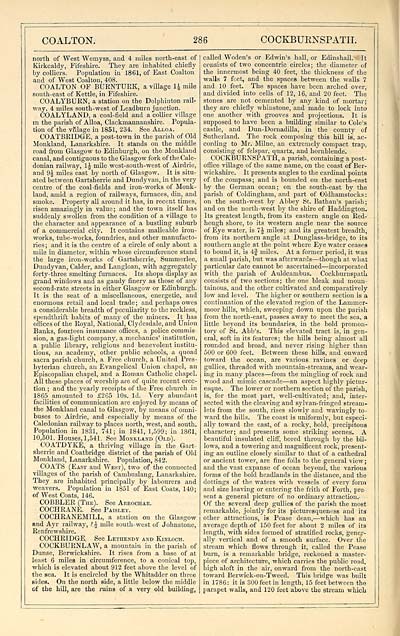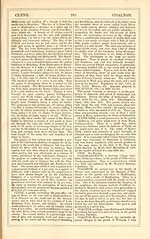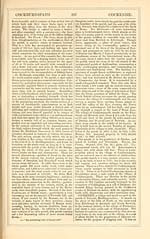Download files
Complete book:
Individual page:
Thumbnail gallery: Grid view | List view

COALTON.
286
COCKBUENSPATH.
north of West Wemyss, and 4 miles north-east of
Kirkcaldy, Fifeshire. They are inhabited chiefly
by colliers. Population in 1861, of East Coalton
and of West Coalton, 408.
COALTON OF BURNTUEK, a village 1J mile
south-east of Kettle, in Fifeshire.
COALTBUEN, a station on the Dolphinton rail-
way, 4 miles south-west of Leadburn junction.
COALYLAND, a coal-field and a collier village
zn the parish of Alloa, Clackmannanshire. Popula-
tion of the village in 1851, 234. See Alloa.
COATBRIDGE, a post-town in the parish of Old
Monkland, Lanarkshire. It stands on the middle
road from Glasgow to Edinburgh, on the Monkland
canal, and contiguous to the Glasgow fork of the Cale-
donian railway, 1$ mile west-south-west of Airdrie,
and 9^ miles east by north of Glasgow. It is situ-
ated between Gartsherrie and Dundy van, in the very
centre of the coal-fields and iron-works of Monk-
land, amid a region of railways, furnaces, din, and
smoke. Property all around it has, in recent times,
risen amazingly in value ; and the town itself has
suddenly swollen from the condition of a village to
the character and appearance of a bustling suburb
of a commercial city. It contains malleable iron-
works, tube-works, foundries, and other manufacto-
ries; and it is the centre of a circle of only about a
mile in diameter, within whose circumference stand
the large iron-works of Gartsherrie, Summerlee,
Dundyvan, Calder, and Langloan, with aggregately
forty-three smelting furnaces. Its shops display as
grand windows and as gaudy finery as those of any
second-rate streets in either Glasgow or Edinburgh.
It is the seat of a miscellaneous, energetic, and
enormous retail and local trade; and perhaps owes
a considerable breadth of peculiarity to the reckless,
spendthrift habits of many of the miners. It has
offices of the Eoyal, National, Clydesdale, and Union
Banks, fourteen insurance offices, a police commis-
sion, a gas-light company, a mechanics' institution,
a public library, religious and benevolent institu-
tions, an academy, other public schools, a quoad
sacra parish church, a Free church, a United Pres-
byterian church, an Evangelical Union chapel, an
Episcopalian chapel, and a Roman Catholic chapel.
AH these places of worship are of quite recent erec-
tion ; and the yearly receipts of the Free church in
1865 amounted to £265 10s. Id. Very abundant
facilities of communication are enjoyed by means of
the Monkland canal to Glasgow, by means of omni-
buses to Airdrie, and especially by means of the
Caledonian railway to places north, west, and south.
Population in 1831, 741; in 1841, 1,599; in 1861,
10,501. Houses, 1,541. See Monkland (Old).
COATDYKE, a thriving village in the Gart-
sherrie and Coatbridge district of the parish of Old
Monkland, Lanarkshire. Population, 842.
_ COATS (East and West), two of the connected
villages of the parish of Cambuslang, Lanarkshire.
They are inhabited principally by labourers and
weavers. Population in 1851 of East Coats, 140;
of West Coats, 146.
COBBLER (The). See Aekochak.
COCHRANE. See Paisley.
COCHRANEMILL, a station on the Glasgow
and Ayr railway, 7.J mile south-west of Johnstone,
Renfrewshire.
COCHRIDGE. See Lethendy and Kinloch.
COCKBURNLAW, a mountain in the parish of
Dunse, Berwickshire. It rises from a base of at
least 6 miles in circumference, to a conical top,
which is elevated about 912 feet above the level of
the sea. It is encircled by the Whitadder on three
6ides. On the north side, a little below the middle
of the hill, are the ruins of a very old building,
called Woden's or Edwin's hall, or Edinshall. It
consists of two concentric circles; the diameter of
the innermost being 40 feet, the thickness of the
walls 7 feet, and the spaces between the walls 7
and 10 feet. The spaces have been arched over,
and divided into cells of 12, 16, and 20 feet. The
stones are not cemented by any kind of mortar;
they are chiefly whin stone, and made to lock into
one another with grooves and projections. It is
supposed to have been a building similar to Cole's
castle, and Dun-Dornadiila, in the county of
Sutherland. The rock composing this hill is, ac-
cording to Mr. Milne, an extremely compact trap,
consisting of felspar, quartz, and hornblende.
COCKBUENSPATH, a parish, containing a post-
office village of the same name, on the coast of Ber-
wickshire. It presents angles to the cardinal points
of the compass; and is bounded on the north-east
by the German ocean; on the south-east by the
parish of Coldingham, and part of Oldhamstocks :
on the south-west by Abbey St. Bathan's parish;
and on the north-west by the shire of Haddington.
Its greatest length, from its eastern angle on Red-
heugh shore, to its western angle near the source
of Eye water, is 7 J miles; and its greatest breadth,
from its northern angle at Dunglass-bridge, to its
southern angle at the point where Eye water ceases
to bound it, is 4f miles. At a former period, it was
a small parish, but was afterwards — though at what
particular date cannot be ascertained — incorporated
with the parish of Auldcambus. Cockburnspath
consists of two sections; the one bleak and moun-
tainous, and the other cultivated and comparatively
low and level. The higher or southern section is a
continuation of the elevated region of the Lammer-
moor hills, which, sweeping down upon the parish
from the north-east, passes away to meet the sea, a
little beyond its boundaries, in the bold promon-
tory of St. Abb's. This elevated tract is, in gen-
eral, soft in its features; the hills being almost all
rounded and broad, and never rising higher than
500 or 600 feet. Between these hills, and onward
toward the ocean, are various ravines or deep
gullies, threaded with mountain-streams, and wear-
ing in many places — from the mingling of rock and
wood and mimic cascade — an aspect highly pictur-
esque. The lower or northern section of the parish,
is, for the most part, well-cultivated; and, inter-
sected with the cleaving and sylvan-fringed stream-
lets from the south, rises slowly and wavingly to-
ward the hills. The coast is uniformly, but especi-
ally toward the east, of a rocky, bold, precipitous
character; and presents some striking scenes. A
beautiful insulated cliff, bored through by the bil-
lows, and a towering and magnificent rock, present-
ing an outline closely similar to that of a cathedral
or ancient tower, are fine foils to the general view ;
and the vast expanse of ocean beyond, the various
forms of the bold headlands in the distance, and the
dottings of the waters with vessels of every form
and size leaving or entering the frith of Forth, pre-
sent a general picture of no ordinary attraction.-
Of the several deep gullies of the parish the most
remarkable, jointly for its picturesqueness and its
other attractions, is Pease dean, — which has an
average depth of 150 feet for about 2 miles of its
length, with sides formed of stratified rocks, gener-
ally vertical and of a smooth surface. Over the
stream which flows through it, called the Pease
burn, is a remarkable bridge, reckoned a master-
piece of architecture, which carries the public road,
high aloft in the air, onward from the north-east
toward Berwick-on-Tweed. This bridge was built
in 1786: it is 300 feet in length, 15 feet between the
parapet walls, and 120 feet above the stream which
286
COCKBUENSPATH.
north of West Wemyss, and 4 miles north-east of
Kirkcaldy, Fifeshire. They are inhabited chiefly
by colliers. Population in 1861, of East Coalton
and of West Coalton, 408.
COALTON OF BURNTUEK, a village 1J mile
south-east of Kettle, in Fifeshire.
COALTBUEN, a station on the Dolphinton rail-
way, 4 miles south-west of Leadburn junction.
COALYLAND, a coal-field and a collier village
zn the parish of Alloa, Clackmannanshire. Popula-
tion of the village in 1851, 234. See Alloa.
COATBRIDGE, a post-town in the parish of Old
Monkland, Lanarkshire. It stands on the middle
road from Glasgow to Edinburgh, on the Monkland
canal, and contiguous to the Glasgow fork of the Cale-
donian railway, 1$ mile west-south-west of Airdrie,
and 9^ miles east by north of Glasgow. It is situ-
ated between Gartsherrie and Dundy van, in the very
centre of the coal-fields and iron-works of Monk-
land, amid a region of railways, furnaces, din, and
smoke. Property all around it has, in recent times,
risen amazingly in value ; and the town itself has
suddenly swollen from the condition of a village to
the character and appearance of a bustling suburb
of a commercial city. It contains malleable iron-
works, tube-works, foundries, and other manufacto-
ries; and it is the centre of a circle of only about a
mile in diameter, within whose circumference stand
the large iron-works of Gartsherrie, Summerlee,
Dundyvan, Calder, and Langloan, with aggregately
forty-three smelting furnaces. Its shops display as
grand windows and as gaudy finery as those of any
second-rate streets in either Glasgow or Edinburgh.
It is the seat of a miscellaneous, energetic, and
enormous retail and local trade; and perhaps owes
a considerable breadth of peculiarity to the reckless,
spendthrift habits of many of the miners. It has
offices of the Eoyal, National, Clydesdale, and Union
Banks, fourteen insurance offices, a police commis-
sion, a gas-light company, a mechanics' institution,
a public library, religious and benevolent institu-
tions, an academy, other public schools, a quoad
sacra parish church, a Free church, a United Pres-
byterian church, an Evangelical Union chapel, an
Episcopalian chapel, and a Roman Catholic chapel.
AH these places of worship are of quite recent erec-
tion ; and the yearly receipts of the Free church in
1865 amounted to £265 10s. Id. Very abundant
facilities of communication are enjoyed by means of
the Monkland canal to Glasgow, by means of omni-
buses to Airdrie, and especially by means of the
Caledonian railway to places north, west, and south.
Population in 1831, 741; in 1841, 1,599; in 1861,
10,501. Houses, 1,541. See Monkland (Old).
COATDYKE, a thriving village in the Gart-
sherrie and Coatbridge district of the parish of Old
Monkland, Lanarkshire. Population, 842.
_ COATS (East and West), two of the connected
villages of the parish of Cambuslang, Lanarkshire.
They are inhabited principally by labourers and
weavers. Population in 1851 of East Coats, 140;
of West Coats, 146.
COBBLER (The). See Aekochak.
COCHRANE. See Paisley.
COCHRANEMILL, a station on the Glasgow
and Ayr railway, 7.J mile south-west of Johnstone,
Renfrewshire.
COCHRIDGE. See Lethendy and Kinloch.
COCKBURNLAW, a mountain in the parish of
Dunse, Berwickshire. It rises from a base of at
least 6 miles in circumference, to a conical top,
which is elevated about 912 feet above the level of
the sea. It is encircled by the Whitadder on three
6ides. On the north side, a little below the middle
of the hill, are the ruins of a very old building,
called Woden's or Edwin's hall, or Edinshall. It
consists of two concentric circles; the diameter of
the innermost being 40 feet, the thickness of the
walls 7 feet, and the spaces between the walls 7
and 10 feet. The spaces have been arched over,
and divided into cells of 12, 16, and 20 feet. The
stones are not cemented by any kind of mortar;
they are chiefly whin stone, and made to lock into
one another with grooves and projections. It is
supposed to have been a building similar to Cole's
castle, and Dun-Dornadiila, in the county of
Sutherland. The rock composing this hill is, ac-
cording to Mr. Milne, an extremely compact trap,
consisting of felspar, quartz, and hornblende.
COCKBUENSPATH, a parish, containing a post-
office village of the same name, on the coast of Ber-
wickshire. It presents angles to the cardinal points
of the compass; and is bounded on the north-east
by the German ocean; on the south-east by the
parish of Coldingham, and part of Oldhamstocks :
on the south-west by Abbey St. Bathan's parish;
and on the north-west by the shire of Haddington.
Its greatest length, from its eastern angle on Red-
heugh shore, to its western angle near the source
of Eye water, is 7 J miles; and its greatest breadth,
from its northern angle at Dunglass-bridge, to its
southern angle at the point where Eye water ceases
to bound it, is 4f miles. At a former period, it was
a small parish, but was afterwards — though at what
particular date cannot be ascertained — incorporated
with the parish of Auldcambus. Cockburnspath
consists of two sections; the one bleak and moun-
tainous, and the other cultivated and comparatively
low and level. The higher or southern section is a
continuation of the elevated region of the Lammer-
moor hills, which, sweeping down upon the parish
from the north-east, passes away to meet the sea, a
little beyond its boundaries, in the bold promon-
tory of St. Abb's. This elevated tract is, in gen-
eral, soft in its features; the hills being almost all
rounded and broad, and never rising higher than
500 or 600 feet. Between these hills, and onward
toward the ocean, are various ravines or deep
gullies, threaded with mountain-streams, and wear-
ing in many places — from the mingling of rock and
wood and mimic cascade — an aspect highly pictur-
esque. The lower or northern section of the parish,
is, for the most part, well-cultivated; and, inter-
sected with the cleaving and sylvan-fringed stream-
lets from the south, rises slowly and wavingly to-
ward the hills. The coast is uniformly, but especi-
ally toward the east, of a rocky, bold, precipitous
character; and presents some striking scenes. A
beautiful insulated cliff, bored through by the bil-
lows, and a towering and magnificent rock, present-
ing an outline closely similar to that of a cathedral
or ancient tower, are fine foils to the general view ;
and the vast expanse of ocean beyond, the various
forms of the bold headlands in the distance, and the
dottings of the waters with vessels of every form
and size leaving or entering the frith of Forth, pre-
sent a general picture of no ordinary attraction.-
Of the several deep gullies of the parish the most
remarkable, jointly for its picturesqueness and its
other attractions, is Pease dean, — which has an
average depth of 150 feet for about 2 miles of its
length, with sides formed of stratified rocks, gener-
ally vertical and of a smooth surface. Over the
stream which flows through it, called the Pease
burn, is a remarkable bridge, reckoned a master-
piece of architecture, which carries the public road,
high aloft in the air, onward from the north-east
toward Berwick-on-Tweed. This bridge was built
in 1786: it is 300 feet in length, 15 feet between the
parapet walls, and 120 feet above the stream which
Set display mode to: Large image | Transcription
Images and transcriptions on this page, including medium image downloads, may be used under the Creative Commons Attribution 4.0 International Licence unless otherwise stated. ![]()
| Gazetteers of Scotland, 1803-1901 > Imperial gazeteer of Scotland, or, Dictionary of Scottish topography > Volume 1 > (396) Page 286 |
|---|
| Permanent URL | https://digital.nls.uk/97463882 |
|---|
| Description | Volume I: Aan-Gordon. |
|---|---|
| Attribution and copyright: |
|

